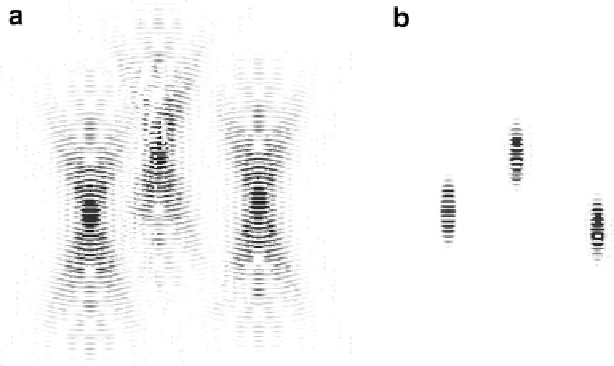Biomedical Engineering Reference
In-Depth Information
Fig. 8.20
Images of sparse particles using (
a
) DHM and (
b
) OCT
This is a characteristic of the backscatter geometry. A clear distinction between
DHM, which uses a single illumination wave and that of the other tomographic
techniques that in effect synthesize images from coherent recordings made with
either multiple wavelengths and/or multiple illumination directions, is apparent.
For the case of DHM (Fig.
8.7
), the axial extent of the PSF is considerably greater
than the tomographic techniques (Fig.
8.13
and Fig.
8.18
). More precisely it can be
shown that the total intensity in any plane perpendicular to the central axis of the
PSF is equal. The effect of the PSF depends on the application. DHM has been used
to measure fluid flow fields in micro-fluidic devices using the technique known as
holographic particle image velocimetry (HPIV) [
36
]. In this application a transpar-
ent fluid is sparsely seeded with small particles and images are recorded at two or
more instants in time. Since the PSF is by definition the image of a point object it is
clear that provided that the particles are sufficiently small their images will take the
form of the PSF. As a particle moves, its reconstructed image will move in
sympathy and the particle velocity can be deduced by estimating the displacement
of its image using correlation for example.
Using the PSFs previously calculated for the DHM and OCT systems a typical
image of a sparsely seeded fluid is illustrated in Fig.
8.20
. The effect of the PSF is
immediately clear. If the particles are separated sufficiently then their images will
be distinguishable and their 3D position can be estimated. If the particles are too
close, however, the images will overlap, interfere, and become indistinguishable
from a uniform background of laser speckle. Analysis shows that an upper limit on
the total number of particles that can be identified in this way is proportional to the
number of pixels required to record an optimally sampled holographic image [
37
].
Additional noise sources reduce this limit, however, and typically around 10
4
particles/mm
3
can be identified in practice.

Search WWH ::

Custom Search